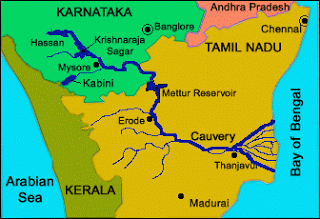From UPSC perspective, the following things are important :
Prelims level: Geographical locations of dams
Mains level: Interstate water disputes

Central Idea:
The article recounts the historical background and negotiations leading to the Agreement between the states of Mysore and Madras regarding the construction and regulation of dams on the Cauvery River. It highlights the challenges faced, key terms agreed upon, and the significance of the agreement in resolving disputes and laying down principles for water management in the region.
Key Highlights:
- M. Visvesvaraya’s proposal for the Krishnarajasagara (KRS) reservoir in 1910.
- Arbitration led by Sir H.D. Griffin resulting in the approval of the KRS dam project.
- Friction between Madras and Mysore over the execution of the dam’s next phase.
- Negotiations and arbitration processes spanning several years.
- Drafting of rules for the regulation of KRS and other reservoirs.
- The signing of the Agreement, facilitating the construction of KRS and Mettur dams.
- Consent for irrigation projects and assurance of water supplies to Madras.
- Perception of the agreement as a fair settlement by Mysore’s Dewan, A.R. Banerji.
Key Challenges:
- Disputes over water rights and dam construction between upper and lower riparian states.
- Lengthy negotiations and arbitration processes due to differing interests and concerns.
- Balancing the need for irrigation expansion with the preservation of water resources.
- Ensuring equitable distribution of water while addressing the concerns of both states.
Main Terms:
- Construction of KRS and Mettur dams.
- Limitation on new irrigation areas under the Mettur project.
- Formulation of rules for the regulation of reservoirs.
- Assurance of water supplies to Madras.
- Review of certain stipulations after 50 years.
Important Phrases:
- “Kannambadi Arbitration Case”
- “Prescriptive right of Madras”
- “Broader settlement”
- “Give and take”
- “British hand”
Quotes:
- “A fair and honourable settlement.” – A.R. Banerji, Mysore Dewan.
- “The spirit of ‘give and take’ reigned throughout.” – A.R. Banerji.
- “No British hand behind the settlement.” – A.R. Banerji.
Anecdotes:
- Sir H.D. Griffin’s swift arbitration process.
- Negotiations between Mysore and Madras officials.
- A.R. Banerji’s statement in The Hindu.
Useful Statements:
- “The pact allowed a review of certain stipulations of the agreement after 50 years.”
- “The agreement was perceived as a fair settlement by both parties involved.”
- “Balancing irrigation expansion with water resource preservation was a key challenge.”
Examples and References:
- Construction of the KRS and Mettur dams.
- Negotiation processes between Madras and Mysore officials.
- A.R. Banerji’s statement published in The Hindu.
Facts and Data:
- Construction of KRS with a capacity of 44.83 TMC.
- Limitation of new irrigation areas under the Mettur project to 3.01 lakh acres.
- Review of certain stipulations after 50 years.
Critical Analysis:
The Agreement marked a significant milestone in resolving the Cauvery River dispute between Mysore and Madras. Despite initial challenges and differing interests, the agreement laid down principles for water management and established a framework for future cooperation. While perceptions may vary, A.R. Banerji’s statement underscores the agreement’s perceived fairness and the spirit of cooperation between the two states.
Way Forward:
The Agreement serves as a historical precedent for resolving interstate water disputes through negotiation and compromise. Moving forward, stakeholders should build upon this foundation to address evolving water management challenges, ensuring equitable distribution and sustainable use of water resources in the region. Cooperation and dialogue remain essential for fostering lasting solutions to water-related conflicts.
Get an IAS/IPS ranker as your 1: 1 personal mentor for UPSC 2024
